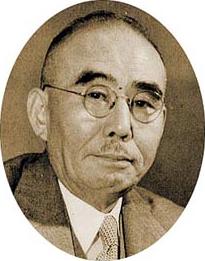Ishibashi Tanzan
Ishibashi Tanzan ( Japanese 石橋 湛山 ; born September 25, 1884 in Azabu (today: Minato ), Tokyo Prefecture as Sugita Seizō ( 杉 田 省 三 ); † April 25, 1973 ) was a Japanese politician of the Liberal Democratic Party . He was the 36th Prime Minister of Japan from December 23, 1956 to February 25, 1957 . From 1952 to 1968 he was President of Risshō University .
Life
Ishibashi was the eldest son of Sugita Nippu , a priest of the Nichiren-shu . His mother Kin was the second daughter of Ishibashi Tōzaemon. The Ishibashi family was an important family of Nichiren Buddhism . The name Tanzan is a monk's name , its profane name was Seizō .
Ishibashi graduated from Waseda University . He then worked as a journalist for the Yokohama Mainichi Shimbun (without any connection to today's Mainichi Shimbun ). After his military service he came to Tōyō Keizai Shimbun , where he rose to chief editor and executive director during the Second World War . He was an opponent of the Japanese participation in the First World War, rejected the Twenty-One Demands on China and later belonged to the few so-called "little Japanese " liberals who not only rejected the expansion policy in China (" Tanaka diplomacy "), but also the renounced already existing colonies and wanted to concentrate on internal economic development and international trade. Like most liberals, he made political concessions to the militarists in the 1930s: although he rejected the creation of the puppet state of Manchukuo , he now supported the demand for trade and investment privileges for the empire in China. After the Pacific War, Ishibashi was one of Yoshida Shigeru's supporters , who wanted to rely entirely on the military and economic support of the United States and, like the political left, opposed extensive rearmament, albeit for different reasons. But Ishibashi soon joined the revisionist foreign policy movement around Ashida Hitoshi , Hatoyama Ichirō and Kishi Nobusuke , who wanted to change Article 9 of the post-war constitution, use the arms industry for economic reconstruction against the backdrop of the Korean War , and push through rapid rearmament.
Entry into politics
After the war, Ishibashi was courted by the Socialist Party of Japan (SPJ); but he stood as a candidate for the Liberal Party in the Shūgiin election in 1946 , but was not elected. Nevertheless, Prime Minister Yoshida Shigeru appointed him to his cabinet as finance minister . In the new election a year later he was finally elected for the 2nd constituency of Shizuoka. In May of the same year, Ishibashi was expelled from political office during the purge by the occupation authorities. In 1951 the ban was lifted, he returned to the Liberal Party and remained a member of parliament until 1963.
As a follower of Hatoyama Ichirōs Ishibashi participated in the founding of the Democratic Party of Japan in 1954 . After the Conservative merger of the Liberal and Democratic Party to form the Liberal Democratic Party in 1955, Ishibashi was one of the party's leading politicians and chairman of its own faction, the Kayōkai ("Tuesday Assembly "). From 1954 to 1956 he was Minister of Economic Affairs under Prime Minister Hatoyama.
prime minister
After Hatoyama's withdrawal, Ishibashi was elected party chairman on December 14, 1956 with 258 to 251 votes against Kishi Nobusuke . As Prime Minister, like his predecessor, he campaigned for an improvement in relations with the Soviet Union , but also spoke out in favor of establishing relations with the People's Republic of China . Just two months after taking office, he suffered a stroke , resigned as party chairman and prime minister and was replaced by Kishi.
After his recovery, Ishibashi remained an advocate for improving relations with the People's Republic of China , visiting the country in 1959 and holding talks with Prime Minister Zhou Enlai .
See also
Individual evidence
- ↑ Risshō University: 歴 代 学長 ( Memento of the original from March 14, 2009 in the Internet Archive ) Info: The archive link was inserted automatically and has not yet been checked. Please check the original and archive link according to the instructions and then remove this notice.
- ^ Richard J. Samuels: Securing Japan. Tokyo's Grand Strategy and the Future of East Asia. Cornell University Press, Ithaca, 2008, ISBN 978-0-8014-7490-3 , chap. 1, pp. 13-37: Japan's Grand Strategies. Connecting the Ideological Dots.
| personal data | |
|---|---|
| SURNAME | Ishibashi, Tanzan |
| ALTERNATIVE NAMES | 石橋 湛山 (Japanese); Ishibashi Seizō (real name); 石橋 省 三 (Japanese, real name); 杉 田 省 三 (Japanese, maiden name); Sugita Seizō (maiden name) |
| BRIEF DESCRIPTION | Japanese Prime Minister |
| DATE OF BIRTH | September 25, 1884 |
| PLACE OF BIRTH | Azabu , Tōkyō , Tokyo Prefecture , Japan |
| DATE OF DEATH | April 25, 1973 |
